 State leaders, particularly state legislators, have a unique role to play in ensuring equitable access to high-quality Career Technical Education (CTE). As the COVID-19 pandemic continues, access and technology gaps have been laid bare, revealing inequities in opportunities for marginalized learner populations. While policies addressing access and equity concerns remained a high priority for legislators in years past, 2021 has been no different; this year to date, almost 30 pieces of state legislation have passed in 17 states addressing this issue. Enacted policies focus on elevating learner voice, examining historically inequitable systems and removing barriers to entry, or providing financial support for historically underrepresented populations. The following policies represent a small sample of equity-focused policies already passed in 2021:
State leaders, particularly state legislators, have a unique role to play in ensuring equitable access to high-quality Career Technical Education (CTE). As the COVID-19 pandemic continues, access and technology gaps have been laid bare, revealing inequities in opportunities for marginalized learner populations. While policies addressing access and equity concerns remained a high priority for legislators in years past, 2021 has been no different; this year to date, almost 30 pieces of state legislation have passed in 17 states addressing this issue. Enacted policies focus on elevating learner voice, examining historically inequitable systems and removing barriers to entry, or providing financial support for historically underrepresented populations. The following policies represent a small sample of equity-focused policies already passed in 2021:
- Colorado SB119 affirms the value of increasing access to industry-recognized credentials for high school students, especially in the wake of COVID-19. The law also requires districts to communicate specific information about work-based learning opportunities and industry-recognized credentials to students and families, and requires the state Department of Education to submit an annual report and communicate similar data to districts.
- Louisiana SB148 creates the M.J. Foster Promise Program, which provides financial assistance up to $3200/year to a low-income learner enrolling in a two-year or shorter postsecondary program in a high-demand, high-wage occupational field aligned with Louisiana’s workforce priorities and leading toward an industry-recognized credential.
- Oregon SB623 directs the State Workforce and Talent Development Board to establish a Committee for Continuous Improvement to conduct an assessment of the Oregon workforce development system. The assessment must incorporate input from historically marginalized groups and other stakeholders and focus on identifying barriers, improving experiences and access to programs, and improving alignment between agencies and nonprofit organizations to ensure individuals impacted most by COVID-19 are prioritized and served.
- Virginia HB1820 expands allowable work activities for Temporary Assistance for Needy Families (TANF) recipients to include participation in educational activities that lead to a postsecondary credential from an accredited higher education institution or other postsecondary school. The credential could include a program resulting in a degree or accredited industry-recognized credential, certification or license.
- Washington SB5194 recognizes the disparate impacts faced by “first-generation college-attending students, students with disabilities, and underrepresented minority students” when applying for or remaining in postsecondary programs, specifically at community and technical colleges. The law announces legislative findings of a need to expand investment in community and technical colleges to guarantee equitable access and requires that all community and technical colleges must submit biennial plans to achieve racial diversity, equity, and inclusion starting July 30, 2022.
Advance CTE’s 2021 Without Limits: A Shared Vision for the Future of Career Technical Education (CTE Without Limits) commits to “All dimensions of equity, including educational, racial, socioeconomic, gender and geographic, and meeting the unique needs of each individual learner,” and promotes many of the same actions connected to these legislative outcomes, including elevating learner voice, supporting equity audits and realigning systems to increase access and funding for marginalized learners. Visit our CTE Without Limits landing page for our call to action and the Learning that Works Resource Center for more access and equity resources.
Dan Hinderliter, Policy Associate


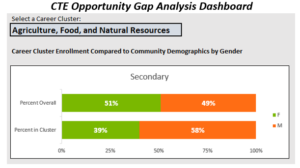 The CTE opportunity gap analysis training was piloted last summer in partnership with Minnesota State Colleges and Universities. Minnesota is organized into 26 consortia to implement the Strengthening Career and Technical Education for the 21st Century Act (Perkins V), each representing the community or technical college and school districts in their service area. Each consortium sent secondary and postsecondary representatives to the pilot workshop.
The CTE opportunity gap analysis training was piloted last summer in partnership with Minnesota State Colleges and Universities. Minnesota is organized into 26 consortia to implement the Strengthening Career and Technical Education for the 21st Century Act (Perkins V), each representing the community or technical college and school districts in their service area. Each consortium sent secondary and postsecondary representatives to the pilot workshop.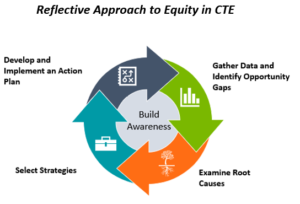 In the second session, participants reviewed their own dashboards — which they prepared in advance with data from the state office — in order to identify learner subgroups that were over- or under-represented across different CTE programs compared to the overall learner population. Participants used a fishbone diagram to identify and map underlying root causes and reviewed intervention strategies and supporting evidence to target recruitment, enrollment and inclusivity of diverse learner populations in CTE. Using this information, they began to develop equity-focused action plans. The workshop, which was aligned with Minnesota’s Perkins V professional development series, was designed to help participants center equity in their Perkins V applications and action plans.
In the second session, participants reviewed their own dashboards — which they prepared in advance with data from the state office — in order to identify learner subgroups that were over- or under-represented across different CTE programs compared to the overall learner population. Participants used a fishbone diagram to identify and map underlying root causes and reviewed intervention strategies and supporting evidence to target recruitment, enrollment and inclusivity of diverse learner populations in CTE. Using this information, they began to develop equity-focused action plans. The workshop, which was aligned with Minnesota’s Perkins V professional development series, was designed to help participants center equity in their Perkins V applications and action plans.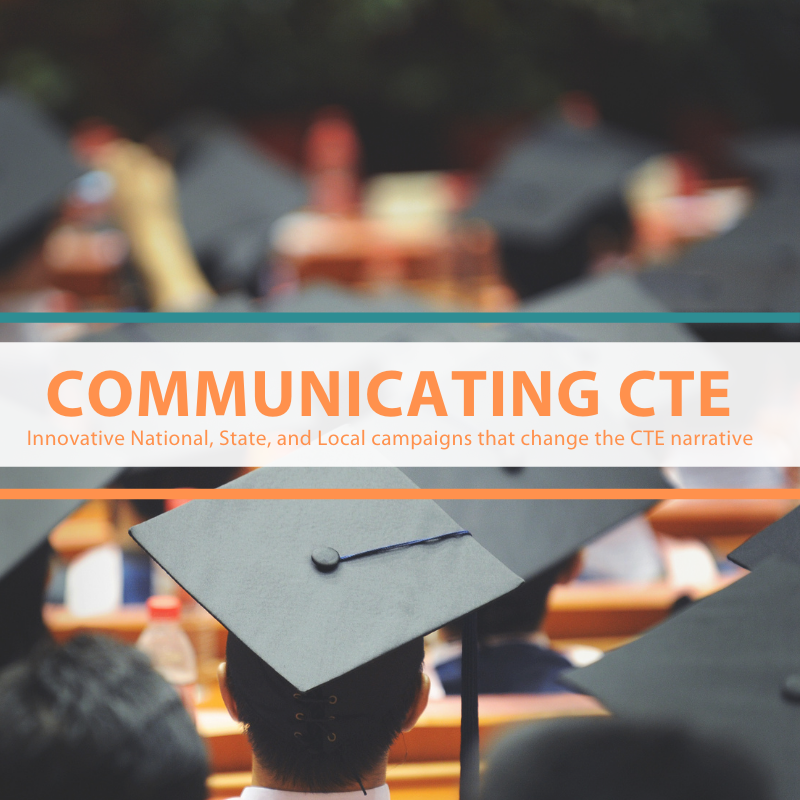 In April 2021, Advance CTE released
In April 2021, Advance CTE released 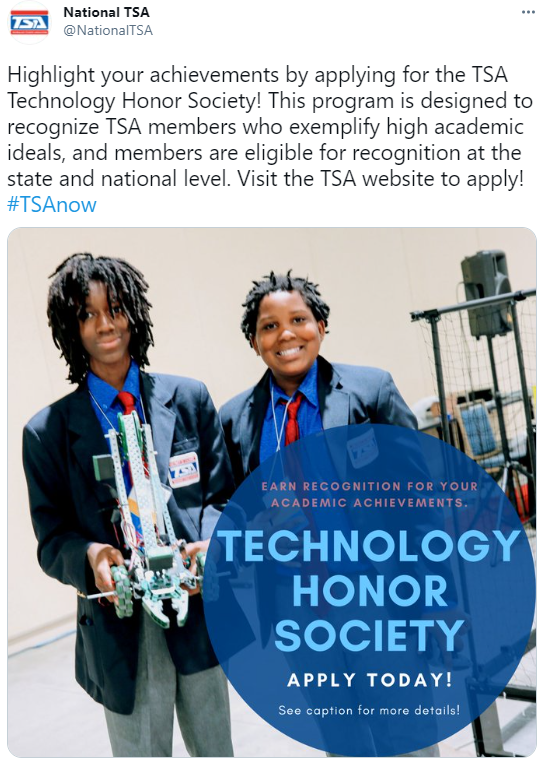 With a focus on recruitment and retention, it is important for learners and families of CTE to see success stories of individuals who look like them and share similar educational, racial, socio-economic, gender and geographic backgrounds.
With a focus on recruitment and retention, it is important for learners and families of CTE to see success stories of individuals who look like them and share similar educational, racial, socio-economic, gender and geographic backgrounds. Families and learners both participating in and considering CTE highly value an education experience that allows learners to explore opportunities after high school that lead to college and career success. In this example, Utah used graphics of learners engaging in real-world skills training to promote its Auto Mechanics and Repairs career pathway. This is a way of demonstrating the connection from CTE courses, work-based learning settings and youth apprenticeship programs to career success.
Families and learners both participating in and considering CTE highly value an education experience that allows learners to explore opportunities after high school that lead to college and career success. In this example, Utah used graphics of learners engaging in real-world skills training to promote its Auto Mechanics and Repairs career pathway. This is a way of demonstrating the connection from CTE courses, work-based learning settings and youth apprenticeship programs to career success.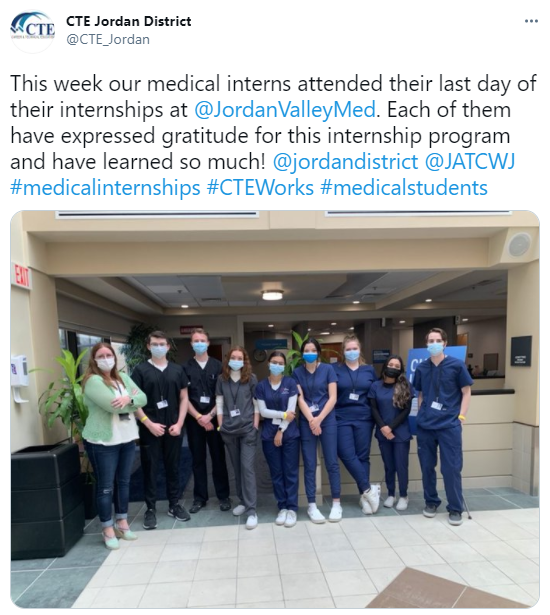 Using local examples can help explain the nuts and bolts of how CTE delivers success by making the connection between CTE and a specific career or industry, as well as highlighting partnerships with local colleges and employers that are recognizable to parents/guardians and learners.
Using local examples can help explain the nuts and bolts of how CTE delivers success by making the connection between CTE and a specific career or industry, as well as highlighting partnerships with local colleges and employers that are recognizable to parents/guardians and learners.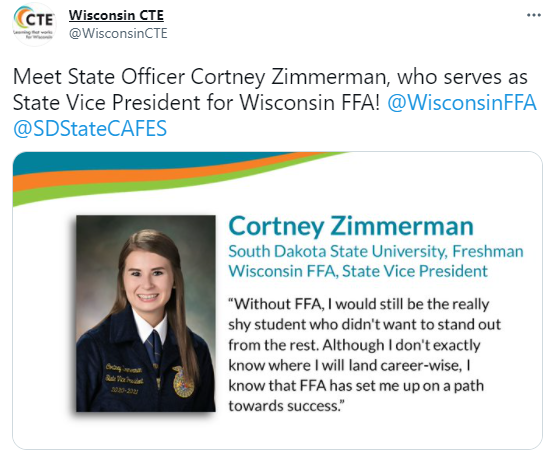 Wisconsin CTE showcased CTE to parents/guardians and learners by lifting up student success stories. One avenue to find compelling learner examples is to coordinate with statewide or local Career Technical Student Organizations (CTSOs) and gather testimonials, photos and stories to share on social media. This tweet focused on a local learner success story to create human interest in CTE. To help expand the reach of this tweet, Wisconsin CTE used relevant hashtags and tagged the state CTSO and the university the learner was attending. This type of post is a great way to highlight CTE and the many ways CTE benefits learners.
Wisconsin CTE showcased CTE to parents/guardians and learners by lifting up student success stories. One avenue to find compelling learner examples is to coordinate with statewide or local Career Technical Student Organizations (CTSOs) and gather testimonials, photos and stories to share on social media. This tweet focused on a local learner success story to create human interest in CTE. To help expand the reach of this tweet, Wisconsin CTE used relevant hashtags and tagged the state CTSO and the university the learner was attending. This type of post is a great way to highlight CTE and the many ways CTE benefits learners.  Meet Christina Koch! Christina serves in the role of Policy Associate for Advance CTE. Christina works on projects related to state policy, including the New Skills
Meet Christina Koch! Christina serves in the role of Policy Associate for Advance CTE. Christina works on projects related to state policy, including the New Skills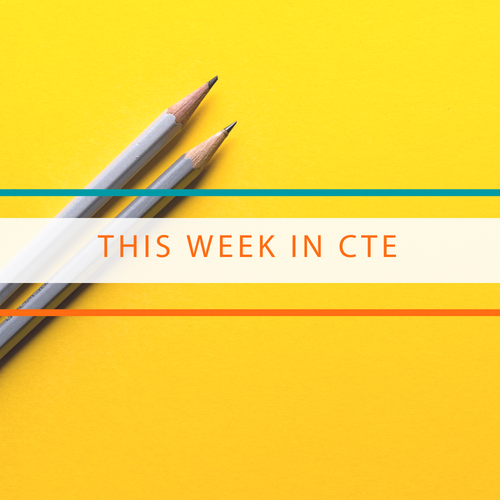 Developed with input from nearly 200 national, state and local education and workforce development leaders and supported by 40 national organizations,
Developed with input from nearly 200 national, state and local education and workforce development leaders and supported by 40 national organizations,  Two hallmarks of a high-quality career pathway are seamless transitions across secondary and postsecondary education and offering learners the opportunity and means to participate in early postsecondary opportunities (EPSOs) – which include dual enrollment, dual credit, concurrent enrollment and other related opportunities. It is critical that these opportunities seamlessly result in articulated postsecondary credit for learners in a degree program that will help them progress on their chosen career pathway with no hidden barriers.
Two hallmarks of a high-quality career pathway are seamless transitions across secondary and postsecondary education and offering learners the opportunity and means to participate in early postsecondary opportunities (EPSOs) – which include dual enrollment, dual credit, concurrent enrollment and other related opportunities. It is critical that these opportunities seamlessly result in articulated postsecondary credit for learners in a degree program that will help them progress on their chosen career pathway with no hidden barriers. A career pathway is a progressive sequence of at least three courses that is aligned to high-skill, high-wage, in-demand occupations; spans secondary and postsecondary; reinforces academic learning with related work-based learning experiences; and embeds opportunities for students to earn both related postsecondary credit in a degree-granting program and industry-recognized credentials.
A career pathway is a progressive sequence of at least three courses that is aligned to high-skill, high-wage, in-demand occupations; spans secondary and postsecondary; reinforces academic learning with related work-based learning experiences; and embeds opportunities for students to earn both related postsecondary credit in a degree-granting program and industry-recognized credentials. 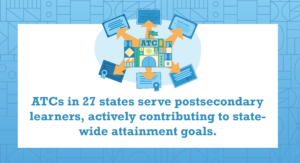 Advance CTE’s recent report on area technical centers (ATCs),
Advance CTE’s recent report on area technical centers (ATCs),  State leaders can look to best practices in data visualization and accessibility to ensure their CTE reporting tools are widely accessible and equip users to make the most of the data.
State leaders can look to best practices in data visualization and accessibility to ensure their CTE reporting tools are widely accessible and equip users to make the most of the data. 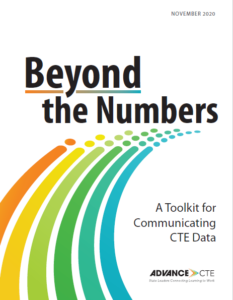 Effective data reporting, however, requires not just well-designed and accessible reports but also a strategy to build understanding among the general public and key stakeholders. What good is data if it isn’t used? Yet state CTE offices are asked to attend to multiple priorities — from program review to professional development to equity monitoring — and communicating CTE data all too often is moved to the backburner.
Effective data reporting, however, requires not just well-designed and accessible reports but also a strategy to build understanding among the general public and key stakeholders. What good is data if it isn’t used? Yet state CTE offices are asked to attend to multiple priorities — from program review to professional development to equity monitoring — and communicating CTE data all too often is moved to the backburner.